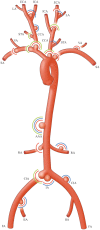Preclinical extracranial aneurysm models for the study and treatment of brain aneurysms: A systematic review
- PMID: 32126875
- PMCID: PMC7181093
- DOI: 10.1177/0271678X20908363
Preclinical extracranial aneurysm models for the study and treatment of brain aneurysms: A systematic review
Abstract
Animal models make an important contribution to our basic understanding of the pathobiology of human brain aneurysms, are indispensable in testing novel treatment approaches, and are essential for training interventional neuroradiologists and neurosurgeons. Researchers are confronted with a broad diversity of models and techniques in various species. This systematic review aims to summarize and categorize extracranial aneurysm models and their characteristics, discuss advantages and disadvantages, and suggest the best use of each model. We searched the electronical Medline/PubMed database between 1950 and 2020 to identify main models and their refinements and technical modifications for creation of extracranial aneurysms. Each study included was assessed for aneurysm-specific characteristics, technical details of aneurysm creation, and histological findings. Among more than 4000 titles and abstracts screened, 473 studies underwent full-text analysis. From those, 68 different techniques/models in five different species were identified, analyzed in detail, and then grouped into one of the five main groups of experimental models as sidewall, terminal, stump, bifurcation, or complex aneurysm models. This systematic review provides a compact guide for investigators in selecting the most appropriate model from a range of techniques to best suit their experimental goals, practical considerations, and laboratory environment.
Keywords: Aneurysm; animal model; endovascular therapy; intracranial aneurysm; saccular.
Figures





Similar articles
-
Saccular Aneurysm Models Featuring Growth and Rupture: A Systematic Review.Brain Sci. 2020 Feb 13;10(2):101. doi: 10.3390/brainsci10020101. Brain Sci. 2020. PMID: 32069946 Free PMC article. Review.
-
The development and understanding of intracranial aneurysm based on rabbit model.Neuroradiology. 2020 Oct;62(10):1219-1230. doi: 10.1007/s00234-020-02475-z. Epub 2020 Jun 27. Neuroradiology. 2020. PMID: 32594185 Review.
-
Testing Stenting and Flow Diversion Using a Surgical Elastase-Induced Complex Fusiform Aneurysm Model.AJNR Am J Neuroradiol. 2017 Feb;38(2):317-322. doi: 10.3174/ajnr.A5018. Epub 2016 Nov 24. AJNR Am J Neuroradiol. 2017. PMID: 27884881 Free PMC article.
-
Endovascular Treatments in Combination with Extracranial-Intracranial Bypass for Complex Intracranial Aneurysms.World Neurosurg. 2018 May;113:e747-e760. doi: 10.1016/j.wneu.2018.02.143. Epub 2018 Mar 3. World Neurosurg. 2018. PMID: 29510287 Review.
-
Rapid saccular aneurysm induction by elastase application in vitro.Neurosurgery. 1997 Jul;41(1):220-8; discussion 228-9. doi: 10.1097/00006123-199707000-00034. Neurosurgery. 1997. PMID: 9218310
Cited by
-
Assessing the aneurysm occlusion efficacy of a shear-thinning biomaterial in a 3D-printed model.J Mech Behav Biomed Mater. 2022 Jun;130:105156. doi: 10.1016/j.jmbbm.2022.105156. Epub 2022 Mar 18. J Mech Behav Biomed Mater. 2022. PMID: 35397405 Free PMC article.
-
Anatomical Variations of the Common Carotid Arteries and Neck Structures of the New Zealand White Rabbit and Their Implications for the Development of Preclinical Extracranial Aneurysm Models.Brain Sci. 2023 Jan 28;13(2):222. doi: 10.3390/brainsci13020222. Brain Sci. 2023. PMID: 36831765 Free PMC article.
-
Aspirin treatment prevents inflammation in experimental bifurcation aneurysms in New Zealand White rabbits.J Neurointerv Surg. 2022 Feb;14(2):189-195. doi: 10.1136/neurintsurg-2020-017261. Epub 2021 Mar 30. J Neurointerv Surg. 2022. PMID: 33785639 Free PMC article.
-
Comparison of Aneurysm Patency and Mural Inflammation in an Arterial Rabbit Sidewall and Bifurcation Aneurysm Model under Consideration of Different Wall Conditions.Brain Sci. 2020 Mar 27;10(4):197. doi: 10.3390/brainsci10040197. Brain Sci. 2020. PMID: 32230757 Free PMC article.
-
Topographic distribution of inflammation factors in a healing aneurysm.J Neuroinflammation. 2023 Aug 2;20(1):182. doi: 10.1186/s12974-023-02863-1. J Neuroinflammation. 2023. PMID: 37533024 Free PMC article.
References
-
- Marbacher S, Niemela M, Hernesniemi J, et al.. Recurrence of endovascularly and microsurgically treated intracranial aneurysms-review of the putative role of aneurysm wall biology. Neurosurg Rev 2019; 42(1): 49–58. - PubMed
-
- Texakalidis P, Sweid A, Mouchtouris N, et al.. Aneurysm formation, growth, and rupture: the biology and physics of cerebral aneurysms. World Neurosurg 2019; 130: 277–284. - PubMed
-
- Stehbens WE.Cerebral aneurysms of animals other than man. J Pathol Bacteriol 1963; 86: 160–168. - PubMed
-
- Muroi C, Hugelshofer M, Seehusen F, et al.. Natural cerebral aneurysm and spontaneous subarachnoid hemorrhage in mammals other than man: is there a scope for comparative medicine? World Neurosurg 2019; 122: 384–389. - PubMed
-
- Hashimoto N, Handa H, Hazama F.Experimentally induced cerebral aneurysms in rats. Surg Neurol 1978; 10: 3–8. - PubMed
Publication types
MeSH terms
LinkOut - more resources
Full Text Sources
Medical

